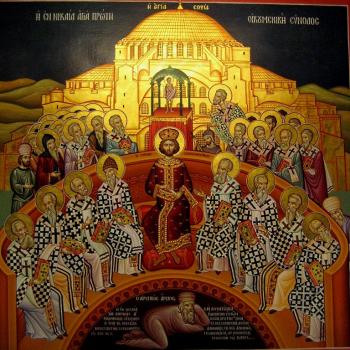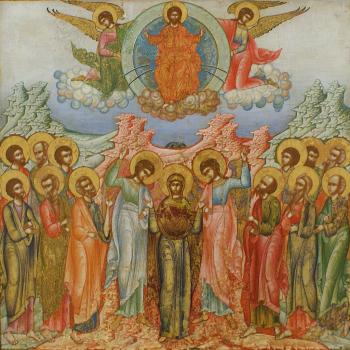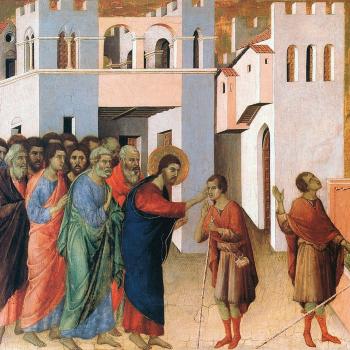
Jesus was greeted by a man whose son suffered from epileptic seizures which often caused the boy to hurt himself. Jesus’ disciples were not able to heal him. Only Jesus was capable of doing so:
And when they came to the crowd, a man came up to him and kneeling before him said, “Lord, have mercy on my son, for he is an epileptic and he suffers terribly; for often he falls into the fire, and often into the water. And I brought him to your disciples, and they could not heal him.” And Jesus answered, “O faithless and perverse generation, how long am I to be with you? How long am I to bear with you? Bring him here to me. And Jesus rebuked him, and the demon came out of him, and the boy was cured instantly (Matt. 17:14-18 RSV).
Many ancient Christians understood psychic and psycho-somatic maladies to be connected to demons; different people had different understandings of those demons: some of them thought them to be fallen angels, but others, following philosophy, thought of them as principles which helped govern the world. The philosophical approach, of course, connects to our more modern approach, not because we look for spiritual entities controlling the material world, but rather, because we look for natural principles, natural causes, for our maladies. What is important is for us to realize is that there was some cause for the boy’s malady, one which we would describe differently than the ancients (though there are many ways to reconcile the two, if we wanted). Jesus, the great healer, dealt with that cause, removing it, so that the boy could be free from the pain and suffering he had endured throughout his life.
Jesus shows us that we can work miracles. T to find cures for what ails us, we must have hope that such cures exist. Take away the cause of a malady, and the malady goes away. Find a way to counteract the effect, and likewise, the malady is treated. We just have to find a way to remove that cause or counteract its effect. Thus, if we suffer a bacterial infection, we find a way to eliminate the bacteria in our body. If we have a tumor in our brain, causing us to act unusual, we remove it (if we can), and we find ourselves returning back to normal. With all that we can suffer, there is a cause, and so there is a solution. It might not be easy. We might not even find it (because of how difficult it is). But the solution is there. We must have faith. And if we do, then we will get to work, hopefully find the solution, and move mountains:
Then the disciples came to Jesus privately and said, “Why could we not cast it out?” He said to them, “Because of your little faith. For truly, I say to you, if you have faith as a grain of mustard seed, you will say to this mountain, `Move from here to there,’ and it will move; and nothing will be impossible to you” (Matt. 17:19-20 RSV).
We can move mountains. We can destroy them. We have learned how to do so with modern day technology. Likewise, when dealing with any allegorical mountain, any obstacle in our way, we must believe there is a solution and work to find it. Jesus said if we have faith, we will be able to move mountains, but of course, he did not say it would be easy for us to move the mountain, or the kind of process we will use to have it moved. The point is that nothing is impossible for us, so long as we believe and work out the problems which we face. The fact that nothing is impossible, therefore, must not be interpreted as everything will be easy once we have faith and act on faith: far from it; all it means is that a solution is possible. Jesus shows us through his work, through the ways he healed people, that indeed, such solutions are possible, but he leaves it up to us to find them. Jesus, the God-man, gives us guidance and grace, but he does not want to intervene in history in any way which undermines human agency.
Faith put into action will transform us; even as we work in the world, seeking solutions to our problems, we will find many without such faith, without such hope, ridiculing us. They will do so for differing reasons. Some will tell us there is no problem to be concerned about. Others will tell us the problem is insolvable. And others will say it can only be solved by immediate supernatural intervention. All of these responses fail to understand human agency. Grace, of course, is needed, but it is freely given by God; human agency, even when it does not know it is grace which it uses and activates, use it in its actions as it realizes its potential, so that it can transcend the problem at hand. Those who work hard, activating their potential, integrating their faith with their actions, not expecting instantaneous solutions, nor thinking no solution is impossible, will often be mocked and ridiculed and treated like fools; but that foolishness is exactly the foolishness which we are to have, following the example of the apostles:
For I think that God has exhibited us apostles as last of all, like men sentenced to death; because we have become a spectacle to the world, to angels and to men. We are fools for Christ’s sake, but you are wise in Christ. We are weak, but you are strong. You are held in honor, but we in disrepute. To the present hour we hunger and thirst, we are ill-clad and buffeted and homeless, and we labor, working with our own hands. When reviled, we bless; when persecuted, we endure; when slandered, we try to conciliate; we have become, and are now, as the refuse of the world, the offscouring of all things (1 Cor. 4:9-13 RSV).
Those of us who have faith must not ignore the problems which lie before us; we must not lie about the problem; we must confront it straight on. We must do what we can to deal with it, doing so, not just for ourselves, but for our neighbor, that is, for the common good. Doing so connects us to Christ, who truly was able to move mountains because he was willing to deal with the problems which lie before him. The greatest problems, sin and spiritual death, were dealt with Christ, not in an instant, but through a long process. We can see it beginning in the pre-history of the incarnation, when God prepared humanity for his birth in human history. Then it continued in the conception and birth of Jesus, in his public ministry, and finally, it reached is conclusion in Jesus’ death, resurrection, and ascension. Together, as a whole, Jesus dealt with the fundamental problem humanity has faced since the beginning of history and he solved it: the process was long, but with his faith (cf. Gal. 2:16), he moved the mountain of death, and its sting is no more.
We are called to move mountains. We are called to have faith which starts out as a seed, such as a mustard seed, and let it grow and blossom until at last, having properly watered it with our faith, hope and love, it grows and provides for us the solution to our problems. We must not presume God will solve things for us without some action on our part. God does not work that way. In the incarnation, we are shown he is God-with-us, and not some absolute which controls and dominates all things. We must believe. The solution is there, somewhere. We just must determine the proper principles and engage them until we find out what that solution is. Then we will find ourselves moving mountains.
Stay in touch! Like A Little Bit of Nothing on Facebook.
If you liked what you read, please consider sharing it with your friends and family!













